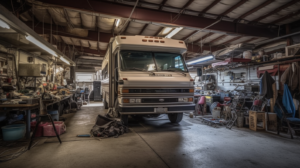
Maintaining Your Vehicle: An RV and Van Maintenance Checklist

If you’re a part of the RV or van life community, you know that your vehicle is more than just a method of transportation – it’s your home. So it’s not just about keeping the engine running smoothly; it’s about ensuring every aspect of your mobile dwelling is in top-notch condition. This article will take you on a journey through the importance of regular RV and van maintenance, how to understand your vehicle, and offer a detailed maintenance checklist.
Why Regular Maintenance is Crucial
Just like your stationary home, your home on wheels needs love and care. Regular maintenance isn’t just about avoiding breakdowns (although that’s certainly a big part of it); it’s about preserving and enhancing the lifespan of your vehicle, and by extension, your nomadic lifestyle. I’ve heard too many tales of full-time RV living dreams cut short due to neglected maintenance. If you want to enjoy the freedom of the open road without worrying about the next potential issue, routine maintenance checks are absolutely crucial.
Understanding Your Vehicle
Whether you’re driving a brand new RV or a retrofitted van, understanding your vehicle’s systems – from the engine to the plumbing and electrical – is an essential part of the van life and RV living. Every make and model is different, and getting to know your vehicle’s unique quirks and features is a journey in itself. Grab that owner’s manual, do your research, and become best friends with your home-on-wheels.
General Maintenance Tips
When it comes to maintenance, consistency is key. Developing a routine and schedule for your maintenance tasks will help ensure nothing slips through the cracks. This includes both professional inspections and DIY checks. Even if you’re not mechanically inclined, there are plenty of simple maintenance tasks you can perform yourself.
Remember, while living the van life or RV life, you might be miles away from the nearest mechanic when an issue crops up. Learning how to handle small fixes can save you a lot of time, money, and stress.
Maintenance Checklist
Here’s the bread and butter of your RV and van maintenance: the checklist. Depending on your specific vehicle and how much you’re using it, some of these tasks might need to be performed more or less frequently. But as a starting point:
- Engine and transmission – Regular oil changes, checking transmission fluid, inspecting belts and hoses.
- Tires and brakes – Regular rotation and balancing, checking tread depth and brake pads.
- Interior and exterior – Sealing any leaks, checking for rust or damage, cleaning and treating surfaces.
- Plumbing system – Cleaning and treating the waste water system, checking for leaks, winterizing if necessary.
- Electrical system – Inspecting wiring, checking battery health, testing outlets and appliances.
- Heating and cooling systems – Cleaning and maintaining the A/C unit and heating system, replacing filters as needed.
Tool Essentials for RV/Van Maintenance
Just like a handyman needs his toolbox, you’ll need a set of essential tools for your basic RV and van maintenance. This includes a quality set of screwdrivers, wrenches, pliers, a tire pressure gauge, a multimeter for electrical tasks, and a reliable flashlight. Don’t forget important spare parts like fuses, bulbs, belts, and hoses specific to your vehicle.
And, since space is always a premium in RV and van life, make sure to store these tools efficiently. A compact, organized tool kit is worth its weight in gold on the road.
Finding a Reliable Mechanic
While DIY maintenance is a big part of RV living and the van life, there are times when you’ll need a professional’s touch. Start by lookingfor a trustworthy RV or van mechanic before you hit the road. Check reviews, ask for recommendations from the community, and take the time to build a relationship with them. Having a pro you can call when things go south can be a huge relief, and their expert advice can be invaluable.
Conclusion
Maintenance may not be the most glamorous part of RV living or the van life, but it’s certainly one of the most important. Keeping your vehicle – your home – in top shape ensures the freedom and joy of the open road continue unhindered. I hope this article has underscored the significance of regular checks and given you a practical guide to follow.
Call to Action
Do you have any of your own RV or van maintenance tips? Maybe a funny story about a DIY fix on the road? We’d love to hear it! Feel free to comment below and share your experiences. And if you need any tools or services mentioned in this article, check out our recommended resources.
FAQs
Q: How often should I perform these maintenance checks? A: The frequency of maintenance checks can depend on many factors including your vehicle’s age, the distance traveled, and the conditions in which you’re traveling. As a general rule, an overall check before and after long trips is a good practice. Always refer to your vehicle’s owner’s manual for manufacturer-specific advice.
Q: I’m not mechanically minded. Can I still do some of my own RV or van maintenance? A: Absolutely! While some tasks might require a professional, many routine checks and maintenance tasks can be done by anyone. Start by getting to know your vehicle, understand its systems and take baby steps towards DIY maintenance. There are also numerous resources and tutorials available online to help you learn.
Q: What should I do if I breakdown in a remote area? A: First things first – it’s essential to have a plan before you hit the road. This includes having roadside assistance coverage, knowing the location of nearby mechanics or service centers along your route, and carrying essential tools and spare parts for emergency repairs. Always let someone know your route and check-in regularly, especially when traveling in remote areas.


Leave a Reply